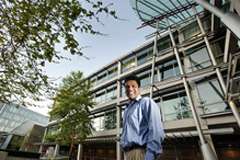Test of building smart sensors yields big energy savings

(PhysOrg.com) -- To reduce energy consumption in commercial buildings, computer scientists at the University of California, San Diego have come up with a way to use real-time occupancy sensors and computer algorithms to create smart heating, ventilation and air-conditioning (HVAC) systems.
Based on early test results, the software- and sensor-based solution produced electrical energy savings of between 9.54 and 15.73 percent on their test deployment on one floor of a 5-floor campus building.
“It’s clear that sensors and computing are key to reducing the demand for electricity in office buildings,” said Yuvraj Agarwal, a research scientist in UC San Diego’s Computer Science and Engineering (CSE) department. “Based on the test deployment, we estimate 40-50 percent in energy savings if we deployed our system across the entire CSE building. This is a significant real-world energy saving that comes while maintaining important quality-of-life measures related to building availability, lighting, comfort and appearance.”
Agarwal presented the project’s initial findings today in a talk on “Duty-Cycling Buildings Aggressively: The Next Frontier in HVAC Control”* at the 10th International Conference on Information Processing in Sensor Networks (IPSN) in Chicago. IPSN is one of several scientific meetings during Cyber-Physical Systems Week and is the premier conference for research in sensor systems.
Buildings account for nearly 40 percent of primary energy use in the United States, and three-quarters of that consumption is electrical—half in residential buildings, half in commercial. Building HVAC systems are therefore ripe as a source of energy efficiency and cost savings.
“Rising energy costs and damage to the environment have made scientists focus increasingly on major contributors to that consumption in the belief that even small improvements can translate into large overall savings,” said Rajesh Gupta, a co-author of the research and associate director of the UCSD division of the California Institute for Telecommunications and Information Technology (Calit2). “We focused initially on computing infrastructure, and that led us to thinking about how to use computers to improve the efficiency of existing systems that regulate when HVAC systems go on and off in buildings.”
Gupta, Agarwal and their colleagues had to look no further than the CSE building where they work, and where HVAC systems usually account for between 25 and 40 percent of total annual electricity load. Like in most commercial buildings, the campus Energy Management System sets HVAC systems on a ‘static occupancy schedule’, i.e., timed to coincide with standard working hours (for the CSE building, from 5:15 a.m. to 10 p.m. on weekdays).
This is done because there is currently no easy and cost-effective way of knowing when individual occupants arrive in or leave their offices.
“The static control algorithm is relatively primitive and it results in a lot of wasted energy during periods of low occupancy,” said Agarwal. “Our solution is a novel control architecture that uses a network of sensors to keep track in real time of which areas of the building are occupied.”
To test their system, the UCSD researchers deployed an occupancy sensor network across an entire floor of the CSE building. The sensors detected several periods of low occupancy when HVAC systems were operating at full steam – and therefore wasting energy. Working with administrators of the campus EMS, the researchers used the real-time occupancy information from each sensor node to turn the floor’s HVAC systems on or off. This so-called aggressive duty-cycling of HVAC systems saved energy while still meeting building performance requirements. The cost of sensors and their deployment is a significant barrier that the team overcame with an in-house design that brought the cost of the sensor to below $10 — one-tenth the price of the cheapest commercial sensor. At that cost, the sensor network can make widespread monitoring and control possible inside buildings.
Instead of simply using passive-infrared (PIR) movement sensors (which are typically used to turn on lights when someone is detected entering an area), the UCSD experiment combined a PIR sensor with a magnetic reed switch. A small magnet is fitted on the door so that when the door is closed, the magnet and reed switch become adjacent, thus detecting when a door is open or closed. In testing, the combined occupancy sensor was accurate 96 percent of the time, with minimal false positives (i.e., not mistakenly detecting someone’s presence in an office when there is no one there).
More importantly, there were no false negatives during the testing phase (i.e., not detecting someone’s presence when they are actually present), which can lead to occupant discomfort if the HVAC system is turned off. The novel sensor nodes are currently designed to detect occupancy, but the same sensors could be expanded to count people or detect environmental parameters such as temperature, humidity, light levels, etc.
To be used widely in all types of new and existing buildings, “these occupancy sensors must be wireless and low power so that they are cost effective to deploy and can run on batteries for several years,” said Agarwal.
In addition to the design and implementation of a low-cost and high-accuracy wireless occupancy sensor node, the UCSD researchers designed a control architecture to actuate individual HVAC zones based on occupancy information.
The sensors are connected to a wireless module and base station, which send the information to a database and computer server that analyzes the sensor data. The team that worked on this project includes Ph.D. students Thomas Weng and Bharathan Balaji. “Working on these energy-saving technologies is extremely rewarding,” said Weng, a third-year Ph.D. student. “You can see the impact of your research immediately around you in terms of real-world savings.” Balaji, who joined the group a year ago, worked on the hardware design of the sensors were used at the core of the occupancy nodes.
More information: ipsn.acm.org/2011/
Provided by UC Davis


















